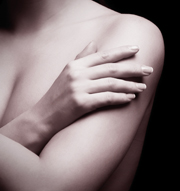BEAUTY - FASHION
BEAUTY Inside & Out
After Breast Cancer: Reconstruction and Recovery
October, 2008 - Issue #48
 |
Besides the medical/surgical interventions needed to remove the disease, what can be done to ensure that a woman's emergence from breast cancer will be a healthy and vibrant one? And what can she do to promote a positive post-operative self-image and sense of wellbeing?
For beginners, reconstructive surgeons often factor high into that equation. They artfully recreate breasts - and self-esteem.
Once a woman is diagnosed with breast cancer, she will ideally meet with her medical oncologist/surgical oncologist who will be performing the mastectomy or lumpectomy, and a plastic surgeon, said Dr. Rady Rahban, a board certified plastic and reconstructive surgeon.
"The goal by meeting the plastic surgeon in the early stage is so the patient learns there are many treatment options available for reconstruction, and to give her hope," stated Dr. Rahban, who is affiliated with Beverly Hills Physicians, a medical group providing cosmetic and plastic surgery services throughout Southern California, including Valencia.
Feeling healed and intact helps foster that hope, and breast reconstruction plays a key role in that quest, the doctor said.
"Today the ideal is to reconstruct a woman's breast immediately following the mastectomy," the surgeon explained. "There are several reasons why that may not be an option but by and large, most women should be offered some kind of immediate reconstruction."
Essentially there are two avenues for reconstruction, Rahban said. One involves using an expander that will later be replaced by a silicone implant. The other utilizes the patient's own tissue, taken during the breast cancer surgery.
"The tissue options available for this procedure include the abdomen, back or buttocks, with the most frequently-used region being the abdomen," he said, adding, "Essentially it is like a 'tummy tuck,' but a bit more involved."
The advantage of this type of reconstruction, Dr. Rahban stated, is that although it makes for a more involved post-op recovery, the results are usually a far more natural looking and feeling breast.
"Although implant reconstruction allows a quicker recovery, the breast will always have an implant feel. Nevertheless, with either technique the main advance today is that women no longer have to spend time following their mastectomy without a breast, and hence the procedure is much more tolerable," he said.
(Note: The type of reconstruction chosen depends on one's body type, age, and cancer treatment. In addition, the location and type of breast cancer, as well as the stage the disease was initially caught, play a role in breast cancer treatment options.)
Although post-reconstruction scar lines remain (healing and time lessen their appearance), and breast/nipple sensation are compromised from surgery, the overall positive after-effects of breast reconstruction are well favored trade-offs. "Patients generally are very pleased with breast reconstruction, especially when using their own tissue," Rahban concluded.
By the way, reconstructive surgery after breast cancer is generally covered by most health insurance policies, although coverage for specific procedures and levels of coverage may vary greatly.
Women choose breast reconstruction for different reasons, said Karen Kim, a certified permanent cosmetic technician who helps breast cancer survivors by performing areola reconstruction, a tattooing process that makes nipples look natural in color and shape.
"Following a mastectomy, some women feel a lack of wholeness or a loss of femininity, while others simply don't like the hassle or worry associated with wearing breast prostheses," said Kim, who practices her therapeutic skills at Cedar Sinai Medical Center in Beverly Hills and at a Cosmetic Laser & Dermatology Center in Santa Clarita on Lyons Avenue.
The areola tattooing procedure involves mixing a desired tattoo pigment, then implanting the color into the dermal layer of the skin of the marked areola and previously reconstructed nipple flaps, said Kim, who is also certified in scar camouflage and other advanced restoration techniques.
Little Steps make for Big Step
Personal Stylist and Image Consultant Shelley Winsor urges women recovering from breast cancer to care for themselves internally as well as externally.
Winsor, who studied at the Sterling Academy of Style in San Francisco, says this mindset helps women regain confidence and "feel pretty again." The rewards are reciprocal, said Winsor, who offers fashion advice, shopping, makeup and skin care recommendations, making accessory choices, proper bra selection, and more.
"I am currently working with a breast cancer survivor. Even though she is a stunning woman, I am helping her through her wardrobe, to feel sexy and to feel like a woman again," the stylist said. "To see her stand a little taller and get a little sparkle in her eye and smile at her reflection is such an amazing reward."
Winsor, a fashion and organization devotee, also goes to clients' homes, examines their wardrobes, and helps get rid of outdated and unflattering clothing, while arranging the closet by color, style and season.
Licensed Esthetician Rosemary Murphy of Beyond Harmony Med Spa in Canyon Country offers some succinct post-breast cancer advice for women: "Spoil yourselves royally!"
"Sometimes, when people experience trauma, they tend to feel isolated, and others even approach them differently, like 'hands-off,'" said Murphy, whose spa offers a wide variety of products and services, including facials, massage, body and med spa treatments and more. "We don't want to touch them because we think it might be too painful, but those are the times that we need to be touched and nurtured the most."
As soon as a doctor gives the green-light following breast cancer treatment, women should start having regular massages and other "pamperings," Murphy stated. "I would also advise them to get a fresh look with hairstyle and makeup to get excited about their appearance again," she said.
Additionally, depending on the extent of their treatments, they may lose their eyebrows; one of the best things they can do is have permanent eyebrows tattooed before they have completely fallen out, she said.
Off Your Chest and Into the Future
Last but definitely not least, a huge tool for coming back from breast cancer is found in sharing feelings with people who have been through similar experiences. Organized through the American Cancer Society and facilitated through Henry Mayo Newhall Memorial Hospital (the site of these meeting), the Bosom Buddy Support Group is one of the local vehicles for discovering that therapy.
The survivor-helping-survivor group, which also provides information for alleviating some of the fear and anxiety caused by breast cancer, meets on October 13 from 7 p.m. to 9 p.m. at the hospital campus' Foundation Room 1. There, breast cancer patients, and their families and friends, will find sharing, caring and facts - chief ingredients for recovering from any serious disease. To attend this group, please RSVP with the American Cancer Society Santa Clarita Valley Unit at 298-0886, option 3.
For More Information...
• Beyond Harmony Med Spa 298-8008
• Dr. Rady Rahban of Beverly Hills Physicians 800-788-1414
• Karen Kim of Cosmetic Pigmentation, Inc. 254-7400
• Shelley Winsor-Personal Stylist and Image Consultant 818-470-0444
Beginning Wednesday, September 17
weSpark Breast Cancer Support Group
weSpark is a special place dedicated to enhancing the quality of life for cancer patients and their families and friends. weSPARK provides, free of charge, a center where one can join with others to share their experience, strength and hope. weSpark offers multiple services designed to heal the mind, body and spirit of all those whose lives have been affected by cancer. They invite residents to a new group to discuss the difficulties of a breast cancer diagnosis; come and meet others who truly understand. Held the third Wednesday of the month; 288-2322
More on Getting in the Pink
When it comes to beating any cancer, an ounce of prevention is always worth a pound of cure.
To apprise women of their insurance company's wellness-incentive benefits, Loreen Worden, a Santa Clarita based Allstate agent, frequently helps hostesses sponsor "pink parties." "The ladies have a good time socializing and we spend a little time talking about the rich benefits of our 'wellness policy,' and then we end with a 'pink gift' raffle," Worden said.
According to the insurance expert, some of the benefits with that Allstate coverage include wellness tests actually being paid to the client. "Just by getting your annual pap and mammogram you can get back $250. If you have a colonoscopy, chest X-ray, mole removed, etc., you'll receive an additional wellness benefit of $50, $75 or $100, depending on the program purchased," Worden explained. All of this money, she said, is rewarded back to clients "just for taking care of oneself." If diagnosed with cancer you'll receive benefits paid to you, she added.
For more information, contact Loreen Worden of Allstate Insurance (and Blue Cross) at 298-5011.
|
||||||||||||||||||||||||||||




